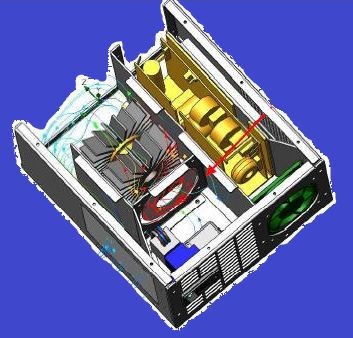October 21, 2013
A number of years ago, a major computer manufacturer stopped by DE to show me its new engineering workstation. I think it was a Pentium box. One of the things they hyped about all their systems is that it’s easy to get inside and swap components, so they popped the panel to show me. And there it was: sticking up from the motherboard with the biggest heatsink you ever saw. It loomed up above everything else like the Bank of America Center does in Charlotte. Seeing me gawking at it, they explained that there was a fan too.
 |
Designing and optimizing heat sinks has come along way since then, but it still seems to me a bit of a black art. Today’s on-demand webinar takes a lot of the mystery out of the process and demonstrates that science can help you master the art of heatsink design.
“Heatsink 101: Everything You Ever Wanted to Know” is a short, 30-minute on-demand webinar packed with details. The end point is that you are shown how you can use simulation to optimize and validate your heatsink design in the application environment. How the presentation works its way to the end point is what makes this an enjoyable and informative presentation.
As you might expect, everything starts right at the beginning with the reminder that heatsinks could more aptly be called heat exchangers because, well, that’s what they do. They transfer heat from a hot surface to a cooler fluid. But that’s a curious aside. No matter how you describe them, heatsinks represent a thermal management issue involving conduction, convection, and sometimes radiation.
The webinar begins with a run through of how heatsinks work, and it ticks off your key heatsink design considerations, such as size, airflow, cost, and attachment methods. From there, it breaks into an in-depth look at thermal resistance, its first and most extensive discussion.
After explaining how thermal resistance algorithms, such as Fourier’s law, are applicable for both convective and conductive heat generation problems, the discussion moves to your considerations when designing a heatsink in the context where it will reside. Here you get into how airflow behaves and interacts with a heatsink. You’ll find a number of thought-provoking screens depicting airflow around the heatsink that show how some of Mentor’s CFD (computational fluid dynamics) tools such as FloTHERM and FloEFD can help you estimate temperatures and identify potential bypass strategies.
The webinar wraps with a couple of real-world application examples as well as a brief Q&A. Interestingly, toward the bottom of the landing page at the other end of today’s Check it Out link, you’ll find a transcript of the Q&A session, a nice touch, IMHO.
“Heatsink 101: Everything You Ever Wanted to Know” is a “101” webinar solely from the fact that it is a grand overview of the topic. Engineers and engineering managers are its audience. This webinar is well illustrated and well paced. Thankfully, the presenter, Alexandra Francois-Saint-Cyr, the Applications Engineering Manager for North America at Mentor Graphics, Mechanical Analysis Division, does not just read the slides. Rather, she uses the slides to guide the discussion by, say, showing the applicable algorithms or by providing an illustration to swell a point being raised.
Mentor Graphics consistently does an excellent job on these kinds of things. If you are a thermal or a board and chassis engineer, or if you have thermal problems with your electronics applications, this on-demand webinar should be right up your alley. Hit today’s link and check it out.
Thanks, Pal. – Lockwood
Anthony J. Lockwood
Editor at Large, Desktop Engineering
Subscribe to our FREE magazine, FREE email newsletters or both!
About the Author
DE’s editors contribute news and new product announcements to Digital Engineering.
Press releases may be sent to them via [email protected].






